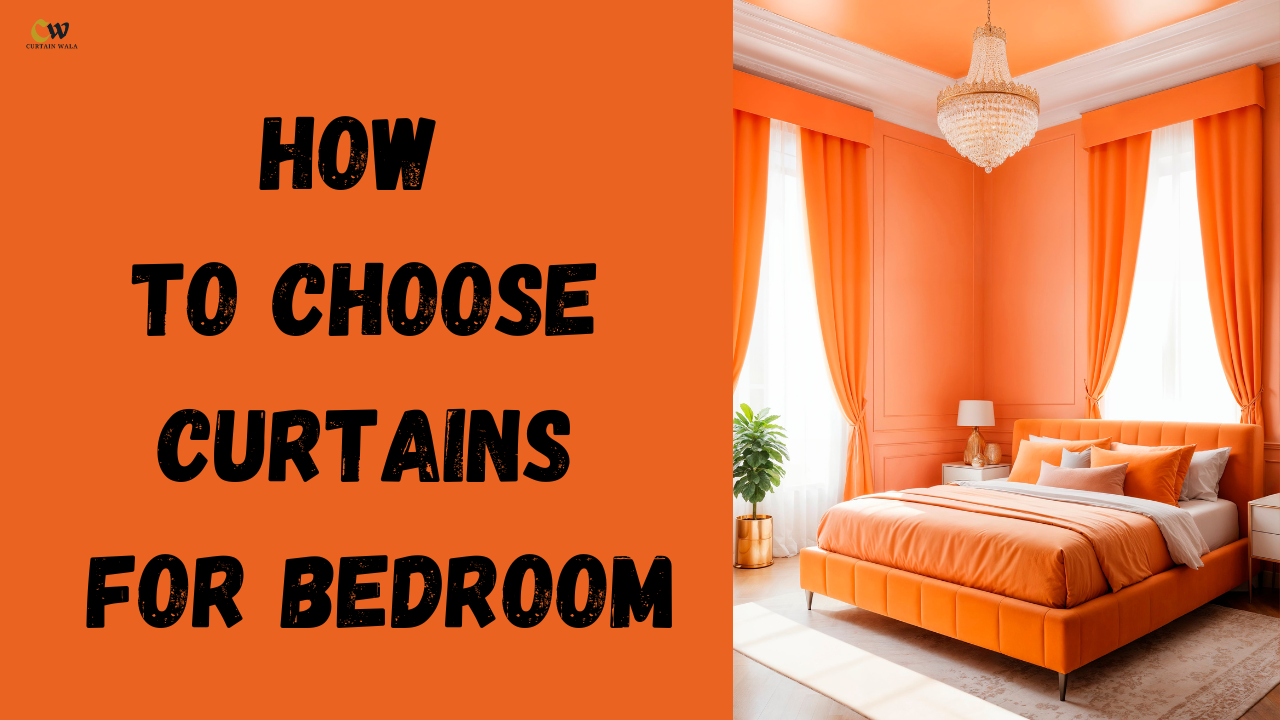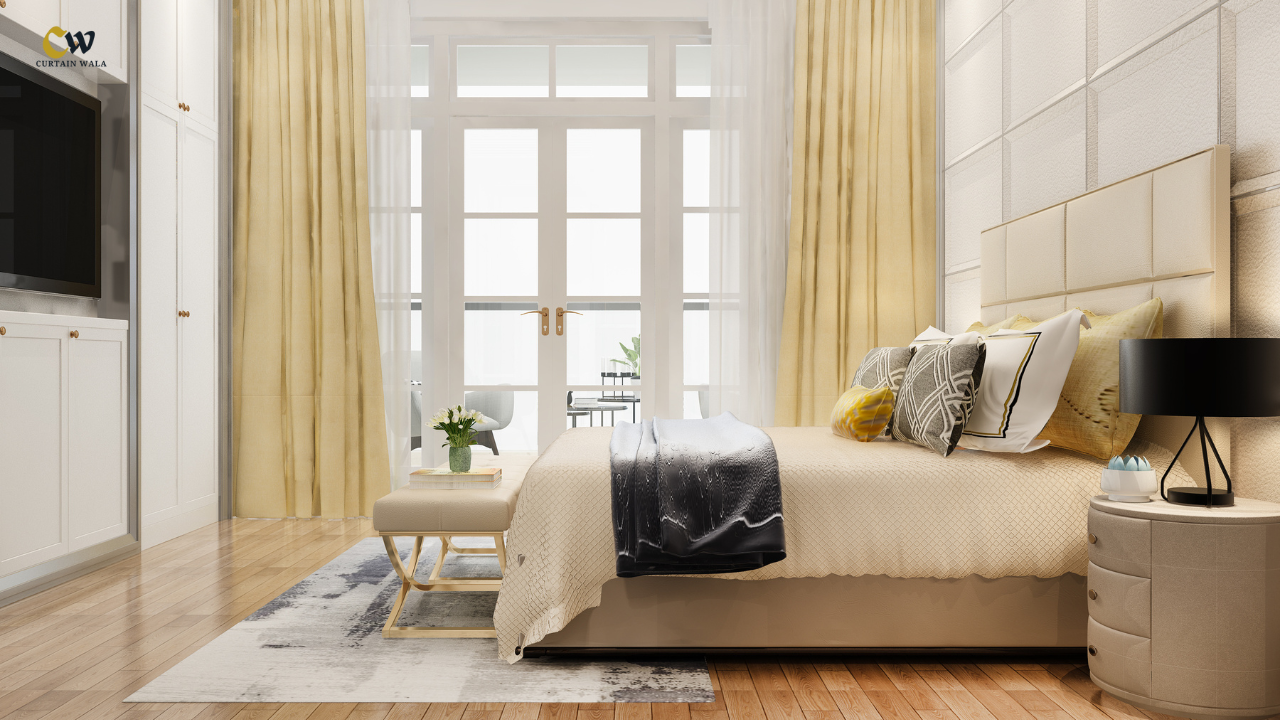
As we talked before about insulating material, curtains are also very important in designing a warm bedroom. They allow privacy, assist to regulate light, and offer the final touch in the interior design of your room. However, given the variety of curtain types available on the market, deciding on the curtains that will be perfect for your bedroom may be a real challenge. Don’t worry! Allow me to explain to you, what kind of curtains are going to work for you and what are the alternatives to choose from.
In this post, we’ll discuss about the various factors that make up curtains that are in terms of fabric and color, style and purpose so that you can easily determine what type of curtain is suitable to go into your bedroom.
Why Curtains Matter in the Bedroom
Now let us discuss why curtains are so crucial in your bedroom before going to the process of choosing them.
- Privacy: Windows and doors of a bedroom open to your bedroom space and curtains meet your privacy needs once you need to feel embraced when inside your bedroom especially if your house is along a busy street or within other people’s compound.
- Light Control: Likewise, curtains give you a way to regulate the amount of sunshine that is entering a specific living area; you may adore natural morning light or you may go to sleep and want to keep the room as dark as possible.
- Style: Blinds are important factors that influence the overall finishing of any room in a particular house. Using them in your room will help to add color, texture and character to the area completing the remaining decorative features.
- Temperature Regulation: Curtains are useful in as far as insulators are concerned, which make the room warmer during the winter and cooler during the Summer thereby increasing energy efficiency in your home.
With these benefits in mind, let me proceed to explaining how you could easily select the best curtains for the bedroom.
Step 1: Choose the Function of Your Curtains
The first question that come to your mind is, why do we need curtains in our bedroom? Are they just for aesthetics or do you require them in your home for issues such as attracting light or enhancing your privacy?
- For Blocking Light: If you need to have a really dark place for sleeping when you wake up easily every sunrise, or when your room is directly exposed to the sun, get yourself blackout curtains. These curtains come with a backing that is designed to have an effective black out on all outside light.
- For Privacy: However, if you are only comfortably phobic but you would still prefer some amount of light to seep in, you then opt for privacy curtains which are made of thick materials, or curtains with blackout lining to complement the room lamps at night.
- For Decoration and Soft Light: If you enjoy feeling light and fresh, and your bedroom isn’t entirely private, it is best to choose gauzy curtains. They allow natural light into the room and add some measure of stylish to the interiors of your home.
Knowing the goal of your curtain will help you to choose the best material and design for your curtains.
Step 2: Choose the Right Fabric
Well, well, well, now that you’ve made up your minds on what function your curtains are going to serve, it’s about time that you decided on the material you want for your curtains. You will find that the fabric of your curtains will not only determine it appearance but also it effectiveness.
- Blackout or Heavier Fabrics: If you have bedroom with strict needs to light control then opt for heavy material like velvet, thick cotton or curtains with a black out lining. These materials are ideal in terms of light blockage,.Temp control, and probably the best of all privacy.
- Lighter Fabrics: Drapery fabrics should be softer and less formal, so choose between pale fabrics such as linen, cotton or voile. These materials let some type of light into the house while still affording seclusion. They’re ideal for bedrooms because they are pleasing to the eye during the day but the shutters will give a dark, intimate ambiance at night.
- Thermal Curtains: Thermal curtains are good for your bedroom if it is draughty or you wish to cut down energy bills for heating and air conditioning. These are normally made of thicker material that of normal curtains and have material that in a way insulates the room and keeps out the cold or retains heat in the room in the respective colder or hotter period.

Step 3: Choose the most Suitable Color and Design
Let me tell you about one of the best parts here – selecting the shade and design of curtains for the bedroom!
- Neutral Colors: Beige, gray, or white are popular because it is impossible to become outdated when choosing such a color. They coordinate with all types of interior design and let you switch the rest of the items in your room, including your bed linen or carpet, without fear of clashing colors.
- Bold Colors: If you person who enjoys something bright, then do not hesitate to opt for such curtains in deep blue or emerald green, as well as burgundy. These colors can bring your curtains front and centre, making them the aesthetic focal point of the furniture layout in your home.
- Patterns: Some ideas of patterns can give a personality to your room but avoid overcrowding the place with them. This one is a good way to avoid making your room too busy if you have patterned bedding or a busy wall. Nevertheless, if your bedroom’s colour is mostly neutral or of some pure hue, then the patterned curtain will bring the necessary activity and interest into the room.
Pro Tip: Consider the feelings you want to have in your bedroom when selecting curtain colors. Light blue or green makes people feel more at ease and relaxed while warm colours such as yellow and orange will make a place more warm or welcoming.
Step 4: Consider Curtain Length and Width
Of course, it is very important to get the size of the curtains right in order for you to get that perfect look. Here’s what to keep in mind:
- Curtain Length: Long length curtains from the ceiling to the floor level will have the effect of making your bedroom taller and also more luxurious. If you want something that appears more dramatic, you can even let your curtains fall on the floor or drape slightly on the floor. On the other hand, curtains that only come down to the level of windowsill or a little beyond it give more relaxed image.
- Curtain Width: In general, the width of curtains should be two to 2 ½ times the width of the window. They make the curtains look fuller when they are drawn which means that you will not have the odd looking curtains with some areas looking thin and needing an extra layer.
Step 5: Don’t Forget About Curtain Hardware
Curtain rods and other hardware are the final component of your curtain installation or the final form of aesthetic appearance of curtains. Selecting the right rod can make a big difference to the curtains aesthetics.
- Curtain Rods: You should select a rod that will blend with the curtains and the rest of decor in the room. Modern rods look best in the bedroom and if one would want them in his or her bedroom, then he or she should look for metallic rods. If your bedroom has more of a traditional look though, wooden rods with ornamental finials might be a better upgrade.
- Tiebacks: In the event that you intend to let natural light into the room by pulling your curtains open in the daytime, use of tiebacks can offer a classy solution to the problem as they offer support in ensuring that the curtains are rolled up on the side.
Step 6: Consider Layering Curtains
Among the most effective modern trends, it is necessary to mention the use of multiple curtains, including both aesthetic and practical purposes. They can use sheer curtains beneath heftier covers in a bid to achieve maximum protection from the sunlight and people spying on them too. For instance, the sheer curtains will be closed during the day to allow some form of light into the room while the other thick curtains at night to blackout the room.
Layered curtains also create a more enriched and texturized look of your bedroom and makes it appear neater.
Selecting the suitable curtains for the bedroom requires little or no considerations. First let’s think about purpose of curtains – do you need them for light control or for privacy or just for decoration? Next, select fabrics, colors and patterns that harmonize with the kind of setup that you have in your room.
FAQs:
- Which material is most suitable for bedroom curtains?
There isn’t a single best fabric, and it all depends on the specific use. However, if one is looking not to let in so much light or for privacy reasons, then fabrics such as velvet or curtains that are lined with black out material will do the trick best. Mattress fabric in light balloon dresses must be made from light materials such as cotton, linen or sheer voile. Thermal fabrics are perfect when it comes to temperatures in hot or cold weather.
- What is the difference between blackout and thermal curtains?
These curtains are specifically used to blackout all the light, ensure they’re purchased for the bedroom if you prefer total darkness. Heated curtains, in contrast, are created for warming, so if you have been feeling cold in winter or hot in summer, then these curtains are meant just for you. Some curtains even come with both functions for flexibility in control of light and heat in the house.
- How many ways are there to measure curtains for the bedrooms?
To get the correct size, measure the width of the window and multiply that measurement by 2 to 2.5 for added fullness. Try whether you want the curtain to touch the windowsill, brush the floor or be just a little lower to have a touch of the throne. It has to rest at a certain position, and measurements should always be taken from the position of the rod not the window frame.
- Should I choose curtains or blinds for my bedroom?
This depends on the kind of look or operation you would wish for the space. Curtains give depth, volume, and character to a space; blinds are modern and functional for optimizing the light. You can also use both of them for achieving a dualіш style where you can use blinds for its use while the curtains are just for ornaments.
- Can I use sheer curtains in a bedroom?
Yes! They can easily lend a touch of fancy draping that will let out proper light into the room. If you require more privacy or light control, you can layer a thin curtain over the blackout curtains or heavier ones so you can have the room change as the occasion demands.




Pingback: Which Curtains for Bedroom Are Best? complete process